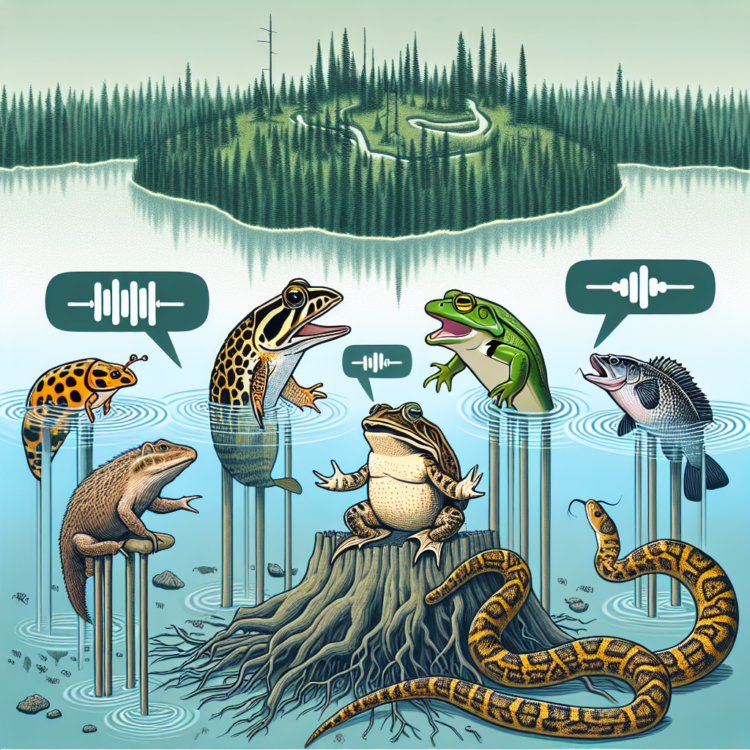Anticipating changes to ecosystems is often at best an educated guess, but what if there was a way to better tune into possible changes occurring?
Anticipating changes to ecosystems is often at best an educated guess, but what if there was a way to better tune into possible changes occurring?
A team of researchers led by Grace O’Malley, a Ph.D. candidate in biological sciences, and Gabrielle Ripa, a Ph.D. student in plant and environmental sciences, have discovered that the silent growth of non-native invasive plants can affect the soundscape of an ecosystem. These altered soundscapes, the acoustic patterns of a landscape through space and time, may provide a key to better observing the hard-to-see physical and biological changes occurring in an ecosystem as they are beginning.
This novel research approach was published this month in the journal of the Ecological Society of America to serve as an invitation to other researchers. Investigating soundscapes is not new, but the idea of looking at the soundscape of an entire ecosystem rather than focusing on a single species within a habitat is new and growing.
“It’s kind of a new way of thinking, in terms of thinking about the ecosystem as a whole instead of about this frog species or this bird species,” said O’Malley, who, along with Ripa are affiliated graduate students with the Invasive Species Collaborative. “Think about it across all taxonomic levels.”
In about 66 areas, many within a 20-minute drive from Virginia Tech’s Blacksburg campus, the researchers set up devices to record five to 15 minutes of each hour. They then compared the sounds from locations invaded by non-native plant species to locations restored to their native state.
“We use these teeny recorders with an SD card that are specifically designed for recording wildlife acoustics,” Ripa said. “I was not prepared for how much data we collected. It’s insane.”
“I was surprised that we were able to observe differences between the two habitats in such a short amount of time,” O’Malley said, referring to an early two-week period for the pilot study. “The invasive plants may actually be changing the soundscape.”
The recording sites included the Jefferson National Forest, Pandapas Pond, and several parks in the Town of Blacksburg because of the town’s restoration efforts to remove many invasive plant species. The data collected for this study can also contribute to a variety of other types of research that includes ecosystems.
“The Town of Blacksburg has been doing a lot of work on autumn olive removal, which is one of our focal species,” said O’Malley.
Having identified gaps in current knowledge and methods, the team suggests further research that delves into several mechanisms by which invasive plant species may alter an ecosystem soundscape and the consequences these unwanted acoustic interrupters could have on the system as a whole.
“It’s a call to other scientists that this is something that we think could be going on,” Ripa said. “We offer suggestions as to what we think could be reasons why invasive plants might be impacting soundscapes and some potential mechanisms that maybe we should be looking into.”
Born out of a whimsical idea suggested by Jacob Barney, professor of invasive plant ecology, the invasive species soundscape concept has now developed into a potential and viable research avenue.
Barney teamed up with Meryl Mims, associate professor of biological sciences who studies bullfrogs and uses acoustics in her research, to look into the possible role of acoustics regarding invasive plants. This led to a pilot study grant from the Institute for Creativity, Arts, and Technology and a collaboration with David Franushich, artist and multimedia designer at the institute.
“This project has been exciting, inspiring, and above all else, fun. Sound is an integral part of how we and other organisms experience and understand our surroundings. The study of the soundscape – and how we are changing it through the introduction of invasive species – is something people connect with,” Mims said. “The formal research is important, but the opportunity to extend the research and ideas to a broader audience through our science-art collaboration has been very rewarding.”
The team received a second grant from the Global Change Center in 2023 to help expand the research, which is still ongoing. Preliminary results are significant in the context of a dearth of scholarly research in this area, prompting the researchers to reach out to other scientists to consider a whole ecosystem acoustic avenue.
“No one’s asked this type of question in this type of system. It’s a completely novel area, and it’s not really being studied,” said Ripa.
Invasive plants do alter ecosystems, and this new study indicates that there may be a way to gain better insight, if only we listen.
The researchers involved in this study include the following:
- Jacob N. Barney, professor, School of Plant and Environmental Sciences in the College of Agriculture and Life Sciences, director of the Invasive Species Collaborative, and faculty affiliate with the Global Change Center and Fralin Life Sciences Institute
- Joseph Drake, postdoctoral researcher in the Department of Biological Sciences in the College of Science, steering committee member of the Invasive Species Collaborative, and affiliate with the Global Change Center and Fralin Life Sciences Institute
- David Franusich, artist and multimedia designer in the Institute for Creativity, Arts, and Technology
- Meryl C. Mims, associate professor of biological sciences in the College of Science, steering committee member of the Invasive Species Collaborative, and faculty affiliate with the Global Change Center and Fralin Life Sciences Institute
- Grace O’Malley, Ph.D. candidate in biological sciences in the College of Science and affiliate with the Global Change Center and Fralin Life Sciences Institute
- Gabrielle N. Ripa, Ph.D. student in the School of Plant and Environmental Sciences in the College of Agriculture and Life Sciences and affiliate with the Global Change Center and Fralin Life Sciences Institute
Journal
Frontiers in Ecology and the Environment




